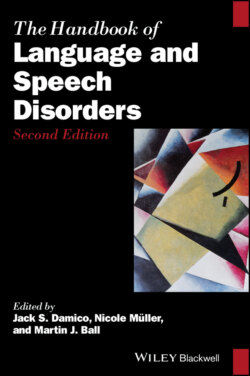Читать книгу The Handbook of Language and Speech Disorders - Группа авторов - Страница 55
3.5 Conclusions and Perspectives
ОглавлениеIf we cross‐reference the audiometric output from an International Standard (ISO 7029) describing nonpathological hearing loss with population data, we find that many of us during our lifetime will experience some degree of hearing loss. This trend will have broad implications for our healthcare service, our society, and for us as individuals. Furthermore, recent advances in our understanding of the underlying causes of early‐stage hearing loss indicate that noise exposure has insidious subclinical effects.
While cochlear implantation is known as the most successful sensory prosthesis to date, inherent limitations in the passage of an acoustic signal directly to the auditory nerve entails some signal degradation, and this is known as the electrical–neuronal perceptual bottleneck. Research findings on the most fundamental goal of CIs, improving communication relative to pre‐implantation expressive and productive ability, have been reviewed. Although CI users are successful in their attainment of some communication objectives, problems remain on all levels of perception and production of language, and of communication in a broader sense. On the phonetic level of speech perception, CI users identify vowels and consonants less successfully than NH individuals, with consonants posing more trouble than vowels. Segments that share spectral properties are more difficult to distinguish. This is in line with the fundamental difficulty that CI recipients evince in perceiving the frequency‐related as opposed to the intensity‐related and temporal dimensions of the auditory signal. In production, CI children have a reduced consonant inventory and smaller vowel space. The impaired pitch perception problems lead to CI listeners missing out on prosodic aspects of speech, such as the signaling of information structure and emotions, issues that in turn may compromise socio‐emotional development in prelingually implanted children. Their prosody production is characterized by a diminished contrast in linguistic (statements vs. questions) and emotional (sad vs. happy) prosody.
CI recipients’ word identification is less compromised than that of the lower level of segments, probably due to an ability to make use of contextual cues. There is evidence that perceptual abilities measured on the phonetic level are partly responsible for those that affect the word level. CI users tend to have a relatively normal sized lexical vocabulary, but their morphosyntactic development lags behind that of their NH peers, a developmental trajectory that is partly dependent on lower‐level abilities, such as phonetic perception. The pragmatic, supralinguistic level of communication in a general sense is impaired, although literacy development is often found to be commensurate with NH controls. These communication issues might, among other factors, have to do with reduced intelligibility. In turn, they might be one of the factors underlying even more global developmental issues, such as behavior and quality of life (Fortunato‐Tavares et al., 2012; Wiefferink et al., 2013).
The cross‐level and task results reviewed in this chapter support the basic assumption that higher‐level communication may be determined, in part, by lower‐level perceptual ability (Huber & Havas, 2019; Wilson & Cleary, 1995), and they thus justify our inclusion of this framework. However, in discussing influences on outcomes, it must be borne in mind that there is much individual variation. Some important factors identified were the negative effect of later age at implantation and the positive effect of longer duration of device usage. For a more complete description of factors, we direct the interested reader to recent reviews (e.g., Gillis, 2018). Research on this complex network of factors remains topical, especially when it can draw on outcomes from large cohorts. Another direction for future research is a reevaluation of—especially long‐term—higher‐level communication abilities, such as discourse strategies (including, turn‐taking, initiative in discourse), speech act usage, and understanding of others’ beliefs, to name a few areas. It has already been proposed that rehabilitation aimed at improving a basic layer of linguistic competition and phonological representations assists in the development of higher cognitive functioning (Lazard, Giraud, Gnansia, Meyer, & Sterkers, 2012). However, more work is required to better define the type and extent of the rehabilitation supporting processing of speech information, for example, vocal emotions (Jiam et al., 2017). To this end, musical training may be a promising avenue (Torppa & Huotilainen, 2019).
